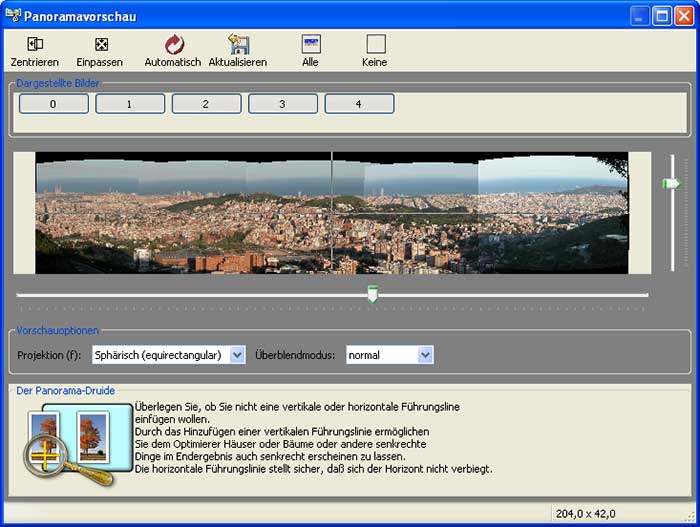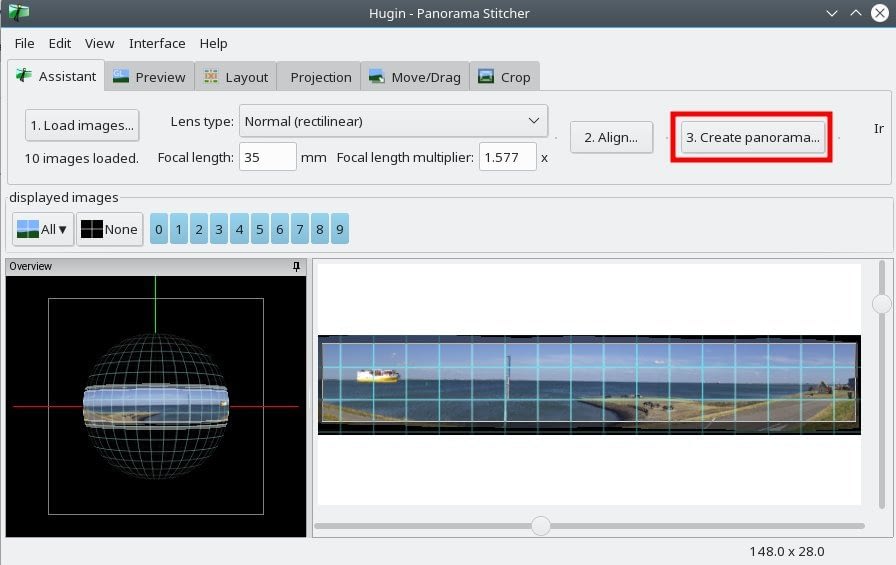
- #Hugin software software#
- #Hugin software plus#
If there's a place where parts of the image don't line up well - eg you see a break in a road - there are couple of likely problems & fixes:
Check the TIFF file to see that the alignment is good. #Hugin software plus#
This will create a TIFF file of the merged images, plus copies of the individual images Hugin used to create it. Tick Layers: > Blended layers of similar exposure, without exposure correction. Tick Panorama Outputs: > Exposure fused from any arrangement. Click Calculate field of view, then Calculate optimal size, then Fit crop to images.  Finally on the "Optimizer" tab, tick the Lens Parameters one by one, optimizing after each and checking it improves things. Add horizontal and vertical lines to get the map as flat as possible. If we try this earlier, Hugin can choose some odd values that break the map up.) tick Yaw, Pitch, and Roll (now we let Hugin adjust for slight differences in camera was in the same orientation between photos. Once all the photos are added and looking good, go back to the "Optimizer" tab and for each photo:. Use "View" > "Fast panorama preview window" to check it's looking ok. ie we assume the camera was in the same orientation for each photo, and just let Hugin slide the tiles around to get the best overlap) tick the box in the "Camera translation" column. untick Yaw, Pitch, and Roll, and make sure all their values are set to zero. add control points to link it to the earlier photos. On the "Stitcher" tab set the Projection: to Rectilinear. On the "Photos" tab, set the Optimize > Geometric: option to "Custom parameters". Start by adding a photo taken near the centre of the map. If the map is made up from several sheets, split the photos into separate directories, one per sheet, and make one Hugin project per sheet. It's a lot easier to retake them now than having to schedule a second trip to the archive! After taking all the photos, check there aren't any that are blurred. Make sure there is a good (30-50%) overlap between shots. Check you're close enough, and focused well, so that all text is sharp. Try to keep the camera at the same distance above the map, and perpendicular to the map surface, for all shots.
Finally on the "Optimizer" tab, tick the Lens Parameters one by one, optimizing after each and checking it improves things. Add horizontal and vertical lines to get the map as flat as possible. If we try this earlier, Hugin can choose some odd values that break the map up.) tick Yaw, Pitch, and Roll (now we let Hugin adjust for slight differences in camera was in the same orientation between photos. Once all the photos are added and looking good, go back to the "Optimizer" tab and for each photo:. Use "View" > "Fast panorama preview window" to check it's looking ok. ie we assume the camera was in the same orientation for each photo, and just let Hugin slide the tiles around to get the best overlap) tick the box in the "Camera translation" column. untick Yaw, Pitch, and Roll, and make sure all their values are set to zero. add control points to link it to the earlier photos. On the "Stitcher" tab set the Projection: to Rectilinear. On the "Photos" tab, set the Optimize > Geometric: option to "Custom parameters". Start by adding a photo taken near the centre of the map. If the map is made up from several sheets, split the photos into separate directories, one per sheet, and make one Hugin project per sheet. It's a lot easier to retake them now than having to schedule a second trip to the archive! After taking all the photos, check there aren't any that are blurred. Make sure there is a good (30-50%) overlap between shots. Check you're close enough, and focused well, so that all text is sharp. Try to keep the camera at the same distance above the map, and perpendicular to the map surface, for all shots. 
Get the best lighting you can: bright, even, and without shadows.You'll probably need some heavy items around the edges, especially if was kept rolled. The unique capabilities of Bayesian Networks and the growing need for developing intelligent, high-performance solutions that can manage uncertainty make Bayesian network technology a key business intelligence technology for the future.If you take several photos of a large map and want to reassemble them into a single image, the Hugin application can help:

Programmed into computers, HUGIN Bayesian network technology automatically compiles and evaluates network information to deduce probability and identify the best solution to a problem or situation.

Therefore, Bayesian networks are extremely useful for modeling complex areas in which sound analysis is needed, but where uncertainty exists. All variables in a network are encoded with probability. Bayesian networks can operate with multiple sources of information: historical data and the more subjective observations of experts and other data that is missing, uncertain or complicated but has valuable impact on the decision support model.Ī cornerstone of Bayesian networks is they are not dependent on having all information about a problem in order to effectively model it. For each variable associated with a cause, probability is used to specify the extent that one variable affects the other.
#Hugin software software#
HUGIN software is based on Bayesian networks and influence diagram technology, an advanced artificial intelligence technique widely used for supporting decision-making under uncertainty.Ī Bayesian network is a graphical modeling tool which organizes the knowledge about a domain into a network of causes and effects between key variables.








 0 kommentar(er)
0 kommentar(er)
